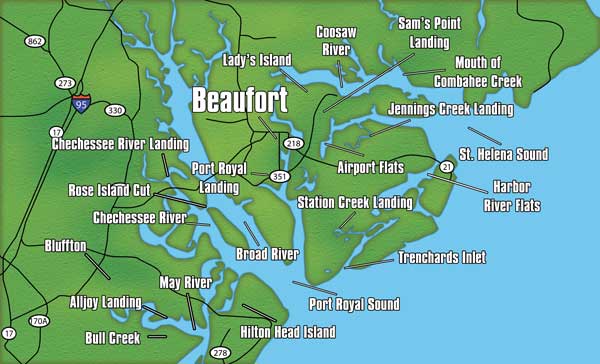
November is prime time for reds and specks in the Beaufort area.
The best shallow-water guides in the Lowcountry around Beaufort and Hilton Head agree that November is high season for both trout and redfish.
Through Thanksgiving, and even into December, the water teems with hungry fish gorging themselves in advance of slim winter pickings.
A winter deep-freeze several years ago killed many of the large speckled trout, making fishing spotty for a while, but harsh winters have been missing since. Add that to the resurgence in the spot-tail bass population — aided by more-restrictive harvest regulations, a heightened awareness of “catch and release” ethics and some stocking programs by S.C. Department of Natural Resources — and you have spectacular fishing opportunities for these two favorite gamefish.
As the water cools, the water clears, and you can begin to spot redfish more easily. Whole fish are rarely spotted more than a long cast away because of the dark bottom, but moving shapes and shadows are more easily seen. Also, because “spot-tails” spend more time in large schools in colder weather, it’s easier to see commotion when the swirl on bait or move around.
Once spotted, cast as soon as they are in range. If the fish have not spooked, make casts to their perimeter and retrieve at a medium-slow speed, with the lure ideally moving across or away from the school’s path. If the fish detect a fisherman before the cast and are slightly spooked, cast into the middle of them and make the retrieve faster, hoping for an instinct strike. Not all the fish in a school will see what is spooking them, and they often strike a lure quickly thrown into their midst.
Cooler water also prompts trout to school and forage throughout the day in shallow water. During the summer, most of their feeding is done at night or in deep water. Finding a school in November will often lead to a banner day.
Working primarily in the St. Helena Sound area, which includes the Harbor, Morgan and Coosaw rivers, Capt. Jack Brown of Predator Fishing, one of the premier light-tackle and fly-fishing guides in the area, said the two months ending around Thanksgiving are his favorite times to chase redfish.
Local guides like Brown already know where the fish are and how to catch them, but when searching for new areas, he looks for a gradual sand flat with grass in the rear portions and oyster beds dotting the sand. If it has a creek feeding into it, that’s even better. A fish-holding flat also must hold at least some water at the lowest stages of the tide so the spot-tails still have a place to escape from bottlenose dolphins.
Fish congregate in such areas year-round, but in November and through the rest of the winter, reds do not actively feed at high tide, so the low-tide flats are where fishermen get plenty of action.
Brown said when you see fish, they may be frothing the water, grubbing the bottom, quietly cruising or just floating in place. The ones that froth the water are chasing bait. When you are in range of such a school, just cast into the commotion, move the lure, and you’ll hook up.
Infrequently, on low-tide flats, you’ll see fish grubbing, an activity that occurs mostly in high-tide shallows, showing their tails, presumably after crabs. Crab flies will work, but almost anything cast near them will elicit a strike. The important thing is getting a fly or jig into the action before they see you and leave. The fly or jig action that Brown recommends is two short, sharp hops or strips followed by a pause, then repeated. The strike will probably be immediate, but if not, keep moving the fly or jig slowly.
Capt. Richard Sykes, an Orvis-endorsed guide associated with Bay Street Outfitters in Beaufort, is familiar with all the water in the area, but he spends much of his time in the St. Helena Sound areas of the Coosaw and Morgan rivers and portions of the Broad River. He also focuses most of his November efforts for spot-tails in low-tide spots.
For live-bait fishing, he rigs spinning rods with traditional popping corks and casts mud minnows or live shrimp. Redfish are normally not too spooky in November, so the splash of large popping corks is not a problem in water that’s at least two feet deep, and the clatter of the brass beads definitely attracts attention.
For shallower water and schooling fish at dead low tide, he will switch to a eighth- or quarter-ounce jighead with a Gulp! or live shrimp or a weedless jerkbait. Gold spoons are also effective on redfish on almost any conditions. He opts for half-ounce Johnson spoons, casting them into shallow water and retrieving them slowly.
When he’s hunting trout, Sykes doesn’t spend too long in any one spot.
“Trout relate to edges, points and oysters, but many spots are water-depth specific,” he said. “Just because a spot was good last week doesn’t mean they’ll be there today, so if you don’t find fish in 10 minutes or so, keep moving.”
In November, trout will be schooled up, moving in and out of areas depending on the availability of food and water depth. Look for points with current, oyster bars with current, up-tide and down-tide sides of major creek mouths and grass edges — especially where oysters break the current flow.
Trout prefer three to four feet of water and will often remain in an area for a short time before moving on. Sykes feels the most productive times for trout are from half-tide rising until about an hour after high tide. He sticks with popping-cork rigs and live shrimp for his bait-fishing customers but often switches to a DOA Shrimp when the local shrimp thin out later in November and into December.
For trout on spinning gear, Sykes opts for 15-pound-test braid on a light rod or 8-pound monofilament on a very light rod for casting and retrieving. For his cast-and-retrieve clients, he often tips eighth-ounce jigheads with Gulp! or other scented trailers. These offerings tempt both trout and spot-tails, with the difference being the depth of water targeted and speed of the retrieve.
One thing Sykes emphasizes is keeping slack out of the line when blind casting or working to visible fish. Lures that hit the water and fall on a slack line often either fall to the bottom and foul with moss, hang up in shells or, if struck by an aggressive fish, are often rejected before the angler feels the strike.
Many Lowcountry fishermen buy the “Top Spot” waterproof map from local tackle shops. It lists dozens of flats and most of the public landings in the sprawling St. Helena and Port Royal sounds and their tributaries. Of the highlighted areas, two of the most popular in the St. Helena Sound area are the Harbor River flats and the Trenchards Inlet flats, both accessible from the boat landing located on Rt. 21 at the Fripp Island Bridge between Hunting Island and Fripp Island, and from Station Creek Landing near the end of Seaside Road on St. Helena Island.
One of Sykes’ favorite areas are the Airport Flats near Warsaw Island. Fish this area on a low and rising tide for spot-tails in the very shallow water. They are often schooled on low-tide flats, relating to oyster outcroppings and shoreline coves. Trout will be found near points as the water rises or falls out of the grass. Also check out the Morgan River shoreline across from Dataw Island Marina
Two convenient landings are the Jenkins Creek Landing on Eddings Point Rd. off Rt. 21 in Frogmore on St Helena Island. or the Sam’s Point Landing on Sam’s Point Rd. (Rt. 802) on Lady’s Island. It allows quick access to Coosaw River spots.
Near Sam’s Point Landing and outside the mouth of Lucy Creek, several areas in the Coosaw River offers points and flats that hold both redfish and trout in November. Also, just outside the mouth of Lucy Creek, upriver and downriver along the banks of Coosaw Island and Lady’s Island are docks and shoreline that hold both trout and redfish. Focus on the lower tide cycles for reds and the higher water for the trout.
In the Port Royal Sound, many fishermen launch at the excellent landing where Rt. 170 crosses the Chechessee River. From there, fishermen can work the Chechessee and the Broad River, including two of the more popular areas, the Hazards Creek Flats and the Daws Island Flats, as well as many others.
From the ramp, run downriver to the Rose Island Cut and cross over to the Broad River side, fishing the flats upriver and downriver from the cut-through for redfish around low tide. On the Paris Island side of the Broad River, below the bridge, are numerous creek mouths that hold trout in November. Farther downriver, just below Archers Creek, is a good redfish flat.


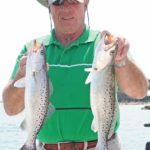
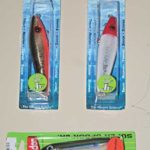
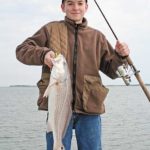
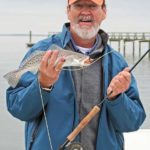
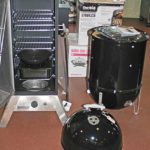
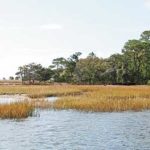


Be the first to comment